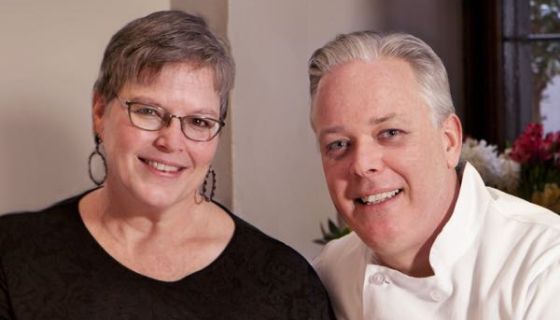The renaissance of 151 East 82nd Street as The Simone and 239 West Broadway as Bâtard demonstrate two fundamental rules of just what it takes to create a successful restaurant.
The first is that a trio of individuals can make it work only if they bring together the requisite, complementary talents. At The Simone, Tina Vaughn generates friendliness and warmth from her reception desk while her husband, Chip Smith, provides the culinary expertise once Robert Margolis had provided the financial nous that finally brought this unassuming couple to their highly appropriate home a year ago. (Vaughn and Smith are pictured here by Lindsay D'Addato.)
Downtown, Drew Nieporent has supplied the location and a cracking wine list (particularly for Burgundy lovers) alongside John Winterman, ex-Daniel, as the genial front of house working with Austrian-born chef Markus Glocker.
Sharing names that doff their cap to French viticulture (Bâtard from Bâtard-Montrachet, Burgundy, and The Simone out of admiration for the Provençal wine estate Château Simone), these two restaurants also underline the second rule, a personal but totally unscientific hypothesis: that restaurant walls seem to absorb the good times customers enjoy in their sanctuary over the years and then release these happy experiences back into the atmosphere once they have been scrubbed up by their new owners.
Each of these restaurants is now in its third incarnation. Bâtard began as Montrâchet almost 30 years ago before a short spell as Corton, whereas the doors at The Simone originally opened as Chez Pascal 45 years ago before a period as Girasole.
In fact turning into 81st off Lexington Avenue, nostalgia seemed to overwhelm me as the view reminded me so much of New York 20 years ago. There was a long green awning above a few steps that leads down to The Simone’s entrance and then into a dining room that houses no more than three tables across and only eleven in total. Vaughn greets one and all, smiling, proud, and extremely keen to ensure that all her customers have a very good evening.
The second expression of the hospitality that is to ensue came after I had ordered a sherry as an aperitif. The bottle arrives and is poured into an obviously old and elegant glass. When I ask the waitress about its origins she replied, 'Yes, it is old. These once belonged to the chef’s grandmother.'
The final source of pleasure arrives via the large menu, handwritten, I discover, by Vaughn herself each evening, that is florid but legible, with the main ingredient underlined and followed in each instance by a string of vegetable accompaniments. As Vaughn explains each dish, the obvious admiration for her husband’s cooking that led her to abandon her career to work with him in their first restaurant in North Carolina, seems to grow and grow.
Two very contrasting first courses highlight Smith’s talents. The first is described on the menu as ‘terrine de maison’ and on the night is a thick slice of pâté de campagne with a pork loin running through the centre, its richness offset by the most precise topping of sea salt. A daily special of Maryland jumbo crab with capers, herbs and avocado is fresh and appetising.
There is a similar contrast in our main courses – a bright piece of flounder with spinach, golden chanterelles and almonds and a darker thigh and loin of rabbit with pearl onions and lardons. A more obvious sense of harmony prevails in our desserts, a pear bavarois and a lemon cream tart that bring our meal, most regrettably, to a refreshing but sweet finale.
Although very different in style and presentation, Glocker’s cooking at Bâtard shares one extremely important trait with that of Smith: both understand that to maximise most ingredients’ flavours, they have to be cooked to the limit. ‘Farm to table’ is a noble expression of freshness but the best chefs can add so much more.
And here again it was the first courses that demonstrated this skill so strikingly. A cauliflower soup, the classic French crème du barry, was poured, a pale, white, creamy liquid, out of its white jug on to a white bowl at the bottom of which lay some curls of onion with just their tips a deep brown. Elegance personified. By contrast, a terrine of octopus was intrinsically far more complex and, lying on top of a thin layer of Meaux mustard, packed a hefty punch.
This thread of seemingly simple, ultra-professional execution continued with a savoury strudel filled with diced Granny Smith apples and sweetbreads, Chatham cod with fennel-seed pasta and, in true Austrian fashion, luscious desserts, particularly a happy combination of pear, warm fromage blanc, schnapps and sage ice cream. Glocker has a fine sensitivity.
Further sources of pleasure are a keenly priced menu at $65 for three courses; an extremely comfortable dining room with good lighting and acoustics – it was fun to be sitting right across the room from the bar and yet still hear the female bartender shaking two cocktails with gusto; and a highly enthusiastic wine team led by the mightily coiffed Jason Jacobeit.
The owners’ styles at Le Simone and Bâtard are very different, yet each is quintessentially New York.
The Simone 151 East 82nd Street, New York 10028; tel +1 212 772 8861. Dinner only Monday-Saturday. Dinner for two $160 without wine or service.
Bâtard 239 West Broadway, New York 10013; tel +1 212 219 2777. Dinner only Monday-Saturday.














